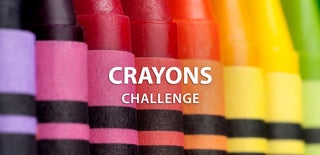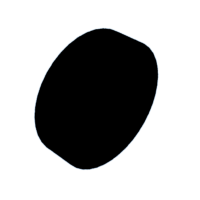Introduction: Craft Room Rotating Crayon Holder
I remember as child often finding it annoying when struggled to get certain crayon out of the box because it was much shorter than the others. It was also sometimes difficult to fit that last crayon back into its box because of how little space there was. With these annoyances in mind I designed this crayon holder to be accessible and organized after some crayons have been used much more than others. I will say that this crayon holder is designed to stay in a craft room or other specified location as it is not very portable, but would be perfect to help teach a child organizational/cleanliness skills early on.
Supplies
For this project will only need a few supplies:
- A 3D printer large enough to print an 8in diameter circle. (Mine is an Ender 3 V2).
- 3D printer filament of your choice. (I used some PLA pro obtained from amazon, because its what I had on hand).
- STL files supplied below.
- Super glue, or any glue that works well with plastic. (I highly recommend getting a gel super glue as I have had a lot better luck using it over liquid and it is much less likely to run and make a mess everywhere).
- Crayola box of 96 crayons.
- Optional: scissors if you decide to cut out and use the crayon sharpener built into the back of the box.
- Optional: 3D modeling software if someone would like to modify the design or use it as inspiration for their own.
Step 1: Design Considerations
Because the majority of this project consists of letting the 3d printer do all the work, I will take this first step to explain the design choices I made in case someone wants to design their own or modify my design to fit their needs better. Feel free to skip ahead if you just wish to print it exactly as I designed.
Disclaimer: The following order of considerations may not accurately represent the exact order in which I designed the crayon holder as it was largely an iterative process and I frequently jumped around and tweaked different aspects at different times.
First Consideration: Number of Crayons
Originally I designed this holder to fit 120 crayons, because I remember that being an option that Crayola sold. I changed it to 96 for two reasons. One, I could not find the 120 box and any of the stores I looked at, and two, the original 120 crayon version was too big to fit on my printer. I know the Ender 3 V2 is a common printer that people would be using and wanted to make sure it would fit.
Second Consideration: Spacing/Sizing
I wanted the crayons to be easy to grab even if some become shorter than others, but realized putting lots of space between adjacent crayons would cause the diameter of the rings to be much too large. For this reason each ring is about 2 inches smaller in diameter than the one below it. This gives enough space between the rings for one's fingers to easily grab the crayon from the front and back. I wanted three rings in total, otherwise it might have been too tall, so I played around a bit with how many crayons to put in each layer so that the geometry would work out for exactly 96 crayons. The combination I ended up with was 40, 32, 24 for tiers one, two, and three respectively. I wanted to make sure that the holes for the crayons were large enough so that the crayons would slide in and out with little to no resistance as well as just long enough to keep the crayon from falling out so that even short or broken crayons would be accessible. Because the diameter of an average Crayola crayon is about 0.3 inches and the length about 3.5, I made the holes 0.4 inches in diameter and 0.9 inches deep, with the rings being 1 inch thick each.
Third Consideration: Assembly
I have seen other people 3D print models in one go that have separate movable parts but I have not designed something like that before so I wanted to design this model in such a way where each piece would be printed separately and then assembled later. I wanted to make sure that the rings would not fit too tightly on the stand so I gave them a bit of clearance so that they would move freely. In order for the rings to be retained I decided there would need to be some sort of cap that would be glued on the top of the stand. I decided to make it a small bowl so that it could hole a few small things like the crayon sharpener from the box or broken bits of crayons that may still get used.
Fourth Consideration: Material Usage/Extra Space
Because this is a fairly large print I was worried about the amount of material it would use. For this reason I designed the rings with the 3 spoke design you see in the images. I made sure that the solid portion of each ring overlapped with the next ring because I did not want any large gaps which would allow crayons or other objects to fall inside of the crayon holder where they would be hard to retrieve or inhibit the rotation of the rings. I also hollowed out the stand to use less material as well. More hollowing could have been done elsewhere but I expected that this would be printed with relatively low infill and so most of the material is in the walls and more hollowing would have just created more walls and the need for supports.
Step 2: Printing the Parts
These parts are relatively simple and forgiving and so I will not go into huge detail about my printer settings and will assume that your printer is set up for whichever filament you are using.
Print each part individually.
The only part that requires supports is the bowl since it has a little pocket on the underside.
If you are also using an ender 3 printer or one with a similar build area you may need to turn off any build plate adhesion options (i.e. skirt, brim, raft) in order to fit the stand and tier 1 on the build plate.
I printed the parts for this model at 20% infill density, but with 3 layer walls to try and save material without compromising strength too much. The only part where it may be wise to print at a higher infill is the stand because the base of it is fairly thin and the top most cylinder could possibly break off if hit or pulled wrong. With these settings the total material usage was a little over 500g of filament and the total print time was a littler over 3 days.
Step 3: Assembly
Assembly of the crayon holder is pretty straight forward.
Place each ring onto the stand (DO NOT GLUE THE RINGS THEY ARE MEANT TO ROTATE FREELY).
Add a bit of glue to the top of the stand as shown as well as some to the wall of the pocket on the bottom of the bowl.
Place the bowl on top of the stand apply some pressure while the glue sets.
Step 4: Add Crayons
Remove the crayons from their original box and place them in whatever order you or your child finds best. You could organize it in a gradient so similar colors are always next to each other, or by warm/cold colors, or simply at random, the choice is yours!
Once the Crayons are added it has enough weight so that the rings spin without the whole thing sliding on the table, but if you have a designated craft room/table and don't want the crayon holder being moved around you could use some double sided tape to fix it to a desk or table semi-permanently.
Step 5: Optional: Crayon Sharpener
The Crayola box of 96 crayons has a crayon sharpener built into the bottom of the box. If you wish to use the sharpener you could simply hold onto the box or as shown here cut it out and store it in the top of the crayon holder.
First, open and unfold the bottom of the crayon box and cut out the sharpener with scissors as shown.
Next, apply some glue as shown and fold the cardboard back together so that the sharpener lines up with the hole. (having two layers of cardboard gives is more rigidity).
Trim the edges with scissors as needed, making sure to leave enough cardboard for you to hold onto while sharpening crayons.
When sharpening crayons it would be best to do so over a trash can or some other container so that the shavings don't make a mess and when finished the sharpener can be stored in the bowl on top of the crayon holder as shown.

Runner Up in the
Crayons Challenge















